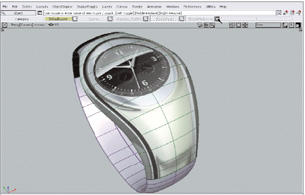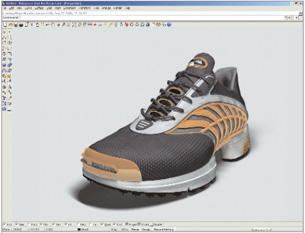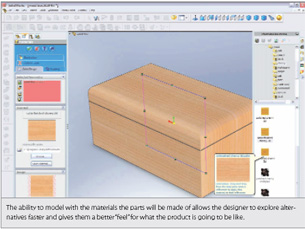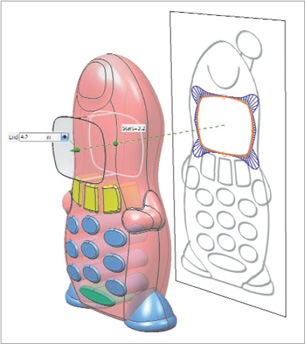Latest News
March 3, 2008
By Mike Hudspeth
 For fast iterations it’s hard to beat the dynamic approach from AliasStudio: The only thing that is actually modeled here in this image is the overall shape. All of the detail is depicted graphically in abitmap image. In the truest fashion imaginable, this is an integrated napkin sketch. For fast iterations it’s hard to beat the dynamic approach from AliasStudio: The only thing that is actually modeled here in this image is the overall shape. All of the detail is depicted graphically in abitmap image. In the truest fashion imaginable, this is an integrated napkin sketch. |
Don’t let your preoccupation with reality stifle your imagination.
— Robert Cassanova and Sharon Garrison of the NASA Institute for Advanced Concepts
In the first installment of this article we took a look at the definition and some of the methodologies in conceptual design. I described conceptual design as the creation, exploration, and presentation of ideas and we asked several representatives of design software companies to comment on how designers could best explore their ideas.
Once again, we will be asking Bob McNeel, whose company develops Rhinoceros modeling software; Paul Brown, director of NX marketing for Siemens PLM Software; and Fielder Hiss, director of product management for SolidWorks, for their opinions as we delve further into the concept of conceptual design. Joining them this time around is Chris Cheung of Autodesk, the developers of AliasStudio — the de facto standard in industrial design software.
Freedom to Explore
According to Fielder Hiss of SolidWorks, consumer and medical product designers typically want to experiment with the surfaces of a new product. The way the product works and acts ergonomically, are key, he says.
“Does the product look cool?” Hiss asks rhetorically. “How does it feel in your hand? Is that the best position for that feature? Machine designers like to sketch out designs and push, pull, drag, and otherwise operate devices before they model them in 3D.”
“The beauty of conceptual design,” says Autodesk’s Cheung, “is it relies on the designer’s skills (mental and physical) to visually communicate the intent of something that does not yet exist. For many designers, a great deal of conceptual work is done in the form of freehand sketching. Typically, it is the fastest route from an idea in your mind to be translated into a physical manifestation that others can look at with less need for verbal or written description … you can see it with your eyes.”
However, Cheung says, not all designers are comfortable with freehand sketching and it becomes important for conceptual design software to bring together the strengths of different visualization techniques. These include 2D sketching and illustration, 3D modeling, and rapid 3D visualization.
“Traditional MCAD packages tend to lack the freedom to explore form without running into the boundaries of constrained modeling,” says Cheung, “so in many ways, this is counterintuitive to the notion of conceptual design.”
 While not exactly impossible to do in a more traditional MCAD modeler, this shoe would be difficult.But for a freeform modeler like Rhino, it is much easier. |
Simple 3D Models will Do
Of course, there are always aspects of conceptual design that people think are more important than they really are, in all practicality. People sometimes place too much emphasis on model accuracy. Rhino’s Bob McNeel says people frequently strive for precision beyond the capability of the material or the fabrication process.
“It is not uncommon for Rhino users to demand that surfaces are 100 to 1,000 times more precise than is possible in the fabrication,” McNeel says. “As an example, when analyzing the behavior of a painted surface, such as an airfoil, it is not uncommon for designers to ask Rhino to make a surface 100 times smoother than the paint. Of course, Rhino can do that, but the designer may have spent hours working on something that will make no difference in the final product.”
“People sometimes overemphasize the digital sketching side of things,” says Paul Brown of NX at Siemens PLM. “Pencil sketches are fast and efficient. Being able to use them effectively is more important than a computer simulation of an already efficient part of the creative process.”
In fact, it is not uncommon to find that many designers think they need a production-quality model at the end of the concept phase.
According to Autodesk’s Cheung, this isn’t exactly wrong, but might cause problems along the way.
“When trying to quickly communicate ideas,” Cheung says, “this adds a lot of unnecessary work and creative strain, especially if, once the concept is tested, it isn’t the right solution and you have to start again from scratch. For pure speed, simple 3D models with details hand-painted in can often do the trick.”
 The ability to model with the materials the parts will be made of allows the designer to explore alternativesfaster and gives them a better “feel” for what the product is going to be like. |
Honoring the Original Design
Historically, designers have preferred using design software that enabled them to explore a range of possible designs quickly and easily without regard to manufacturability, cost, etc. MCAD tools typically weren’t viewed as being “designer-friendly,” so designers would simply use the tools they were comfortable using, and then would pass these conceptual designs onto engineers who would recreate the designs in an MCAD program. As a result of this “handoff” to engineering, sometimes the design would change dramatically and leave the designer feeling that the design intent had been lost.
According to Rhino’s McNeel, this sometimes happens when the MCAD modeler feels the need to parameterize the shape. “It is often remodeled even when there is no requirement in the software to do so,” he adds. To find out how this can be avoided using today’s evolved MCAD tools, we asked our panel to address this challenge.
“The main evolution has been that high-end systems like NX have acquired very specialized expertise,” says Siemens PLM’s Paul Brown, “such as industrial design surface modeling.”“ ‘Lost in translation’ is unacceptable,” asserts Hiss of SolidWorks. “]SolidWorks is] as powerful as any other conceptual design tool, but it has the added benefit of preserving design intent. Users can automatically leverage all their conceptual work when they move to 3D and the engineering phase.”
“The conflict between designers and engineers is not about tools, but about process,” says Cheung. “Today, innovative products are a result of collaboration and teamwork. Some organizations try to make designers and engineers use the same MCAD tool, thinking that this solves the problem. But what it does is it forces designers to use tools not suited to conceptual exploration and in the end, the final product can suffer when it gets to market.” Cheung adds that designers need access to creative tools that address their workflow while engineers still need the right tools to successfully complete their jobs.
 The ability to integrate conceptual design functionality with mechanical engineering capability allowsNX modeling to cover a lot of bases that once required multiple software packages. |
What To Do Differently
If process and collaboration are the keys, then it makes sense that the people involved need to adjust what they do. We asked our experts what changes they would recommend.
“Designers and product managers should be more exposed to how their products are actually fabricated,” says McNeel. “For example, very often we see products with high free-form content developed in Rhino, then handed off to engineering because the corporate standard is a traditional MCAD system that is not focused on precision free-form surfaces.” From there, he adds, the product is often handed off to an Asian partner for manufacturing where the free-form parts must be “remodeled again in Rhino because of the changes needed for efficient manufacturing.”
Brown suggests, “Marry the conceptual design team with core product engineering.” Products like NX, he says, can complete the product lifecycle, “but in many cases organizational structure is still somewhat segmented. This makes it harder to capitalize on the benefits of true integration.”
Fielder Hiss has a similar take on the subject: “I would like to see everyone try conceptualizing within SolidWorks so they can appreciate the benefits and the smooth transition to hard engineering,” he says. “I think many designers would be pleasantly surprised.”
Industrial design often continues to get short shrift from company leaders and others, says AliasStudio’s Cheung. “I would like to see business further recognize the value of design,” he says. “Often, industrial design is misunderstood, in that people believe it is just about styling and aesthetics (the box around the engineering), when in reality it is what ties together functional aspects with the human element, the emotional connection with the consumer and their lifestyle, and ultimately the definition of the brand.” (As an industrial designer I couldn’t have said it better myself, Chris.)
Actual Savings
Aside from the benefits of making sure design intent is translated well and cultivating a truly collaborative product-development team, there are other pluses to adjusting the process. There are savings to be had as well. We asked our panel about the time and money companies estimate that they are able to save using advanced conceptual design and virtual design tools.
McNeel says it is difficult to pinpoint what companies might save “since all design tools are virtual, except physical prototypes.” He estimates, though, that depending on the analysis required, savings to companies can range from trivial amounts to substantial ones. “For example,” he says, “wind tunnel or tank testing often is not all that expensive ]when] compared to setting up and running CFD analysis. It is often easier to make the design iterations by playing around with a handful of clay and turn the wind tunnel back on, than it is to change the computer model and rerun the CFD analysis. But structural analysis of a large building design has to be done virtually. Physical analysis is economically impossible.”
“According to the recent Aberdeen research study,” says Cheung, “companies that follow Digital Prototyping practices bring their products to market 58 days faster than the competition with 46 percent less physical prototypes and with more innovation. Conceptual design is part of this process, but what is slightly less tangible is the impact it has on making a successful product. Today, design influences the success of a product more than any other factor.”
The Future For Conceptual Design
To end our session, we asked the panel where conceptual design was headed in the future. Here’s what our experts said:
“More of the integrated analysis tools will become real-time,” asserts McNeel.
“We believe there will be higher creativity and increased creation speed,” says Brown. “Also, the software will enable higher levels of reality and feedback to the designer.”
“It’s got to be even easier, and it’s got to be embedded in the MCAD software,” says Hiss. “Users deserve nothing less than a seamless transition from the freeform, artistic mode to the mathematical mode to the 3D mode.”
Finally, according to Cheung, while the software offerings will continue to evolve, Autodesk will look to democratize the technology and improve workflow practices, especially in the “ever-critical” conceptual design phase. “If you take a look at products like Autodesk SketchBook Pro,” he says, “you can see how natural user experience and interaction play a key role in software applications, ultimately helping users to not think about software and be more productive at their work.”
Conceptual design, then, remains one of the most important parts of any product’s development. It is not the only part to be sure, but without exploring possible solutions to your design problems, you can very quickly find yourself designing what no one needs, what no one can build, and what no one will buy.
More Info:
Autodesk, Inc.
San Rafael, CA
autodesk.com
McNeel North America
Seattle, WA
rhino3d.com
Siemens PLM Software
Plano, TX
siemens.com/plm
SolidWorks Corp.
Concord, MA
solidworks.com
Mike Hudspeth is a senior designer for a global medical company and has more than 20 years experience slinging CAD. He, his wife, and two daughters live outside of St. Louis, MO. Send him an e-mail about this article to [email protected].
Subscribe to our FREE magazine, FREE email newsletters or both!
Latest News






